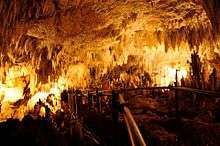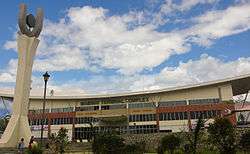Mabinay
| Mabinay | |
|---|---|
| Municipality | |
| Municipality of Mabinay | |
|
Mabinay Terminal Complex | |
| Nickname(s): "The Cave Capital of the Philippines" | |
 Map of Negros Oriental with Mabinay highlighted | |
.svg.png) Mabinay Location within the Philippines | |
| Coordinates: 09°44′N 122°55′E / 9.733°N 122.917°ECoordinates: 09°44′N 122°55′E / 9.733°N 122.917°E | |
| Country | Philippines |
| Region | Negros Island Region (NIR/Region XVIII) |
| Province | Negros Oriental |
| Congr. district | 2nd district of Negros Oriental |
| Barangays | 32 |
| Government[1] | |
| • Mayor | Ernie "Jango" T. Uy |
| • Vice Mayor | Enozario Baldoza |
| Area[2] | |
| • Total | 319.44 km2 (123.34 sq mi) |
| Population (2015)[3] | |
| • Total | 78,864 |
| • Density | 250/km2 (640/sq mi) |
| Time zone | PST (UTC+8) |
| ZIP code | 6207 |
| Dialing code | 35 |
| Languages | Cebuano, Hiligaynon (Ilonggo), Filipino, English |
| Website |
www |
Mabinay, officially the Municipality of Mabinay (Cebuano: Lungsod sa Mabinay; Filipino: Bayan ng Mabinay) is a first-class municipality in the province of Negros Oriental in Negros Island Region, Philippines. According to the 2015 census, it has a population of 78,864 inhabitants, making it the most-populous municipality in Negros Oriental.[3] Its location roughly halfway between Bacolod and Dumaguete makes it the regional center of the Negros Island Region, along with neighbouring Kabankalan City to its north-west in Negros Occidental.
Geography
Mabinay is situated roughly in the central part of the island of Negros abutting the western side of the provincial boundary. The municipality of Ayungon bounds it in the north, the City of Bais in the south, the municipalities of Bindoy and Manjuyod and a portion of Bais in the east, and the province of Negros Occidental in the west. It is about 87 kilometres (54 mi) north-west of the provincial capital, Dumaguete City and can be reached via the circumferential but well-paved national road that cuts across the middle of the province from Bais City to Negros Occidental.
Barangays
Mabinay is politically subdivided into 32 barangays.[2]
- Abis
- Arebasore
- Bagtic
- Banban
- Barras
- Bato
- Bugnay
- Bulibulihan
- Bulwang
- Campanun-an
- Canggohob
- Cansal-ing
- Dagbasan
- Dahile
- Himocdongon
- Hagtu
- Inapoy
- Lamdas
- Lumbangan
- Luyang
- Manlingay
- Mayaposi
- Napasu-an
- New Namangka
- Old Namangka
- Pandanon
- Paniabonan
- Pantao
- Poblacion
- Samac
- Tadlong
- Tarâ
History

Folklore has it that the beautiful Binay fell in love with the son of her father’s rival chieftain. Her father ended the affair by having her lover killed. Binay grieved. Mother Nature took the weeping maiden into her bosom. Where Binay was laid to rest, a spring broke forth. She weeps to this day, feeding Mabinay Spring, one of the town’s many alluring attractions.
A more intimate visit to Mabinay will indeed take you to her bosom. This is a spelunker’s haven: over 100 known caves, including the popular Pandalihan, Panligawan and Gasidlak, each one with its own distinctive features ranging from fascinating to awesome. A team of Belgian and Dutch cavers determined Odloman Cave to be the second longest in the Philippines.
Mabinay was carved from barrios of Bais and created a municipality in 1960. In 1966 more barrios of Bais and Manjuyod were annexed to enlarge it. Mabinay produces rice and corn, copra, soybeans and peanuts. Its principal crop, sugar cane, makes it an important member of the north’s sugar district. It is a border town: the Provincial Highway runs through it and links Negros Oriental with its sister province.
A rolling terrain makes exploration of this interior town a ruggedly charming experience. Travel from Dumaguete City is about two hours.[4]
Demographics
| Population census of Mabinay | ||
|---|---|---|
| Year | Pop. | ±% p.a. |
| 1990 | 58,935 | — |
| 1995 | 62,939 | +1.24% |
| 2000 | 67,001 | +1.35% |
| 2007 | 70,548 | +0.71% |
| 2010 | 74,187 | +1.85% |
| 2015 | 78,864 | +1.17% |
| Source: National Statistics Office[3] | ||
Education
The Mabinay National High School (formerly Mabinay Municipal High School) is a high standard accredited institution according to the Philippine Department of Education.
Mabinay Science High School is a Secondary Public Science High School system that is a DepEd-recognized institution.
The Santo Niño High School is a private Catholic institution located at Barangay Lumbangan.
On June 16, 1997, the Sangguniang Bayan (Municipal Council) Resolution No. 94 established the Mabinay Institute of Technology (MIT), a technical college operated with the approval of the Department of Education, Culture and Sports. On June 25, 2004, the Mabinay Institute of Technology (MIT) was integrated into the newly converted university,[5] Negros Oriental State University by virtue of the university charter, Republic Act No. 9299 signed by President Gloria Macapagal Arroyo on June 25, 2004 and to be known as Mabinay Campus (NORSU-M).
Attractions

Mabinay is known for its caves. The Odloman Cave is one of the largest cave in the Philippines with 8,870 metres (29,100 ft) long and Cayaso Cave, the ninth longest cave in the country measuring 2,222 metres (7,290 ft) long.
Aside from the caves, Mabinay also has rivers and natural springs. One of its known natural spring is located at the heart of the municipality, the Mabinay spring. Ideal for family outing, swimming, kayaking, it also serves as the main water resource of the main town. It is about a 3 to 5 minute ride with tricycle, jeepney or a bus from the town center.
Health services
Mabinay itself has a small government-run hospital. Mabinay Medicare Community Hospital provides both in emergency outpatients services and inpatient services. It is located directly behind the Municipal Hall. Mabinay Health Center, one of three Mabinay health centers.
Transportation
Motorcycles or "habal-habal", tricycles, jeepneys, and buses are the major modes of transportation in the municipality.
References
- ↑ "Elected Mayors – Vice-Mayors and Councilors in Negros Oriental". Dumaguete.com. Retrieved 2016-05-15.
- 1 2 "Province: Negros Oriental". PSGC Interactive. Makati City, Philippines: National Statistical Coordination Board. Retrieved 12 March 2013.
- 1 2 3 "NEGROS ISLAND REGION (NIR)". Census of Population (2015): Total Population by Province, City, Municipality and Barangay (Report). PSA. Retrieved 20 June 2016.
- ↑ "About | Cities & Towns", Negros Oriental Tourism Office. Retrieved 2013-05-28.
- ↑ "History of Negros Oriental State University", Negros Oriental State University. Dumaguete City, Negros Oriental. Retrieved 2013-05-28.
External links
| Wikivoyage has a travel guide for Mabinay. |
- Mabinay Official Website
- Philippine Standard Geographic Code
- Philippine Census Information
- Local Governance Performance Management System
 |
Kabankalan, Negros Occidental | |
Ayungon |  |
| |
Bindoy Manjuyod | |||
| ||||
| | ||||
| Bayawan | Bais City |
